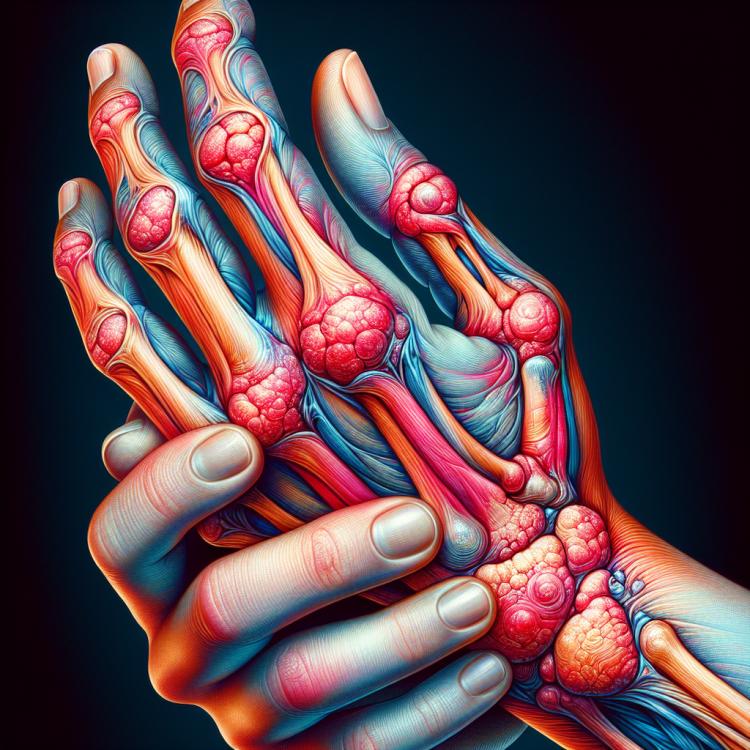
Purulent arthritis: manifestations, causes, and treatment methods
- Understanding purulent arthritis
- Predisposing factors for purulent arthritis
- The main signs of purulent arthritis
- Approaches to the treatment of purulent arthritis from the experts’ perspective.
- Methods of diagnosing purulent arthritis
- Methods of treating purulent arthritis
- Measures for the prevention of purulent arthritis
- Intriguing moments about purulent arthritis
- FAQ
Understanding purulent arthritis
Purulent arthritis, also known as septic arthritis, is an infectious inflammatory disease of the joint caused by the entry of microorganisms into the joint cavity. This type of arthritis is characterized by severe pain, swelling, and a limited range of motion in the joint. Confirmation of the diagnosis of purulent arthritis usually requires analysis of synovial fluid obtained through joint aspiration to identify the causative agent of the infection.
For the successful treatment of purulent arthritis, immediate initiation of antibiotic therapy aimed at eliminating the infection is essential. In some cases, surgical intervention may be required to drain pus from the joint. Without timely treatment, purulent arthritis can lead to joint destruction and serious complications, making it important to consult a medical professional at the first signs of the disease.
Predisposing factors for purulent arthritis
Factors contributing to the development of purulent arthritis include bacterial infections such as Staphylococcus aureus and Streptococcus. These pathogens can enter the joint through trauma, surgical intervention, or bleeding, leading to inflammation of the joint capsule and accumulation of pus.
Furthermore, reduced immunity, rheumatological diseases, diabetes, and obesity are additional risk factors for the development of purulent arthritis. Identifying the specific source of infection and the prompt initiation of antibacterial therapy are crucial for the successful treatment of this serious condition.
- Bacterial infections: Staphylococcus aureus and Streptococcus can enter the joint and cause inflammation of the joint membrane.
- Weak immunity: A weakened immune system can make the body more susceptible to infections, including purulent arthritis.
- Rheumatological diseases: Some rheumatic diseases increase the risk of developing purulent arthritis.
- Diabetes: Patients with diabetes have an increased risk of developing infections, including purulent arthritis.
- Obesity: Excess weight can put additional pressure on the joints and increase the likelihood of developing purulent arthritis.
The main signs of purulent arthritis
The main symptoms of purulent arthritis are the sudden onset of severe pain, swelling, intense redness, and an increase in temperature in the affected joint area. Patients may also experience limited movement in the joint due to inflammation and the accumulation of pus.
Suspicion of purulent arthritis should be raised by any rapid deterioration of the joint’s condition, the appearance of the aforementioned symptoms, and general malaise. Diagnosing this disease requires a comprehensive approach, including clinical examination, laboratory tests, and instrumental methods, for timely diagnosis and the initiation of appropriate treatment.
- Severe pain: characterized by sharp, intense pain syndrome in the affected joint.
- Swelling: accumulation of fluid in the joint cavity leads to swelling and an increase in the volume of the affected joint.
- Skin redness: the skin above the affected joint becomes red and warm to the touch due to inflammation.
- Temperature increase: localized increase in temperature is observed around the affected joint.
- Limited movement: due to inflammation and pain, the patient may experience difficulties with the mobility of the affected joint.
Approaches to the treatment of purulent arthritis from the experts’ perspective.
Experts in the field of rheumatology and infectious diseases unanimously emphasize the importance of timely and adequate treatment of septic arthritis. The principles of therapy include joint drainage to remove pus, the prescription of antibiotics to combat the infection, and anti-inflammatory medications to reduce inflammation and pain.
Experts also highlight the necessity of an individualized approach to the treatment of each case of septic arthritis, taking into account the patient’s characteristics, the type of infectious agent, as well as the level of complications. Exceptional importance is placed on monitoring the dynamics of the patient’s condition, regular monitoring of laboratory indicators, and timely adjustment of therapy to successfully overcome this serious infectious disease.

Methods of diagnosing purulent arthritis
The diagnosis of purulent arthritis includes clinical examination, laboratory studies, and instrumental methods. Clinical examination is important for identifying classic symptoms of arthritis, such as tenderness, swelling, and limited movement in the affected joint. Laboratory studies, such as blood and joint fluid analysis, can be used to determine the level of inflammation and identify pathogens causing the infection. Instrumental methods, such as X-ray or magnetic resonance imaging, can help to show changes in the joint associated with arthritis.
It is important to remember that the diagnosis of purulent arthritis requires a comprehensive approach and prompt response. Timely and accurate diagnosis is critically important for selecting optimal treatment and preventing complications associated with this condition.
- Clinical examination: Includes checking for symptoms of arthritis, such as tenderness, swelling, and limited movement in the affected joint.
- Laboratory tests: Blood tests and joint fluid analysis may be used to determine the level of inflammation and identify pathogens causing infection.
- Joint fluid analysis: Analyzing joint fluid helps to identify the presence of inflammation and the presence of an infectious agent.
- X-ray: Used to detect changes in the joint, such as destruction of bone tissue, which may indicate arthritis.
- Magnetic resonance imaging (MRI): Allows for a more detailed examination of the condition of the joints, providing additional information about inflammatory processes and tissue damage.
Methods of treating purulent arthritis
In addition to medication, physiotherapy and rehabilitation can also be important components of recovery after purulent arthritis. They aim to improve joint mobility, relieve pain, and restore function. In some cases, surgical intervention may be required to clean the joint and repair damaged tissues.
- Use of antibiotics: to eliminate the bacterial infection responsible for purulent arthritis, a course of antibiotics tailored to the sensitivity of the pathogen is often required.
- Joint drainage: a procedure performed to remove pus from the affected joint and relieve pressure, allowing the joint to heal and recover.
- Use of anti-inflammatory medications: to reduce inflammation, pain, and swelling in the joint, anti-inflammatory drugs are often used.
- Physiotherapy: physical exercises and procedures can help restore joint mobility, strengthen muscles, and improve blood circulation in the affected area.
- Surgical intervention: in cases where conservative methods do not yield the expected results, surgical intervention may be necessary to clean the joint, repair damaged tissues, or address other complications.
Measures for the prevention of purulent arthritis
Regular consultations with a rheumatologist, especially in the presence of risk factors for the development of arthritis, can also help timely identify and monitor the condition of the joints. Adhering to the doctor’s recommendations, undergoing preventive examinations, and the timely initiation of treatment for other diseases that contribute to the development of arthritis play a crucial role in preventing purulent arthritis and its complications.
- Hygiene compliance: Regular handwashing and wound care help prevent the entry of infection into the body through the skin.
- Avoiding injuries: Preventing physical damage to joints helps avoid the possible development of purulent arthritis.
- Rational nutrition: A balanced diet with adequate levels of vitamins and minerals contributes to strengthening the immune system and reducing the risk of diseases.
- Active lifestyle: Regular physical exercise helps maintain joint health and improves the overall condition of the body.
- Timely consultation with a doctor: Immediate medical assistance at the first signs of infection or arthritis promotes early detection and the start of treatment for the disease.
Intriguing moments about purulent arthritis
Another interesting aspect is that purulent arthritis most often affects large joints, such as the knee, elbow, and hip joints, but can also occur in other joints. Understanding the symptoms, causes, and treatment methods of purulent arthritis is important for timely diagnosis and successful management of this condition.